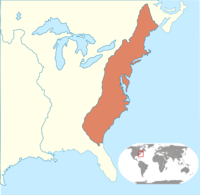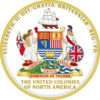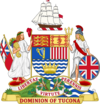Dominion of Tucona
This article refers to a micronation or element of micronationalism which is defunct and no longer exists. You can help make the article reflect that or ask on the talk page for further information. |
United Colonies of North America | |
|---|---|
| Motto: "Libertas Virtute Perennis" | |
| Anthem: The Liberty Song | |
 Claimed territory highlighted in orange | |
| Status | Provisional Self-proclaimed Dominion |
| Capital | West Caesarea |
| Official languages | English |
| Religion | Secular State |
| Demonym(s) |
|
| Government | Federal semi-parliamentary constitutional monarchy |
• Monarch | Charles III |
• President-General | Ronnie Miller |
| Legislature | Grand Council |
| Foundation | |
| 10 May 1775 | |
| 2 July 1776 | |
• Allegiance restored | 25 April 2021 |
• Government restoration | 30 November 2021 |
| Population | |
• Estimate | 6 |
| HDI | 0.943 very high |
| Currency | United States dollar ($) |
| Time zone | Eastern Time Zone |
| Date format | dd-mm-yyyy |
| Driving side | right |
Tucona, officially the Dominion of Tucona and formally the United Colonies of North America, is a North American micronation established in 2021. It is a self-declared restoration of the United Colonies that existed prior to American independence, and claims the former Union's territories within the borders of 1776. The micronation seeks to achieve recognition as a Commonwealth realm. The United Colonies exercises no authority over the territory it claims, nor is its existence acknowledged by the Crown or any sovereign nation. Nevertheless, the country maintains its seat of government and de facto embassy in the province of West Caesarea, and advocates for Tucona's self-governance.
The dominion was founded by American citizen Ronnie Miller as a project of self-government and historical education. However, it has developed into a cause of defending the British origins and independence of the United Colonies. Tucona embodies the achievements of liberty and self-governance through the early years of the American Revolution, fused with the natural born rights of Englishmen.
Etymology
Tucona is an acrostic of The United Colonies of North America, the original name of the Thirteen British American Colonies. The government maintains the long format as formal and historical name of the union. Shortened forms include: the Union and the United Colonies.
History
Colonial Period
Main article: Thirteen Colonies
Founding
In 1775, the Second Continental Congress convened to represent the grievances of the United Colonies, later acting as the de facto national government at the outset of the Revolutionary War. Through the Declaration of Causes and the Olive Branch Petition, the Continental Congress affirmed the United Colonies' loyalty to the Crown. It was only after King George III issued the Proclamation of Rebellion on 23 August 1775, that the United Colonies moved towards independence.
The government of Tucona maintains that the original cause of the Continental Congress is just, and carries the positive attributes of the American Revolution while remaining loyal to the crown.
Independence
The short-lived Dominion of Hartland was formed on 19 April 2021 by local residents to protect the original mission of the Second Continental Congress in allegiance to the crown. By 25 April, an Act of Union was formalized to create Tucona, the modern successor state of the 18th century United Colonies. Hartland became the first province to enter the federation. Tucona joined the Commonwealth of British Dominions initially as Hartland on the date of its independence.
Early Actions
The government of Tucona arose as a moderate, non-intervening force during the Vancouver Island territorial dispute, later defending the rights of self-determination of the residents of Vancouver Island. Following the establishment of the second Dominion of Vancouver Island, Tucona established a period of hesitancy to fully recognize their sovereignty. Tucona withdrew from the Commonwealth of British Dominions due to disagreements with internal members in the aftermath of the Vancouver Island dispute.
Restoration
After a period of decline, the Dominion of West Caesarea and the Delaware was founded from a brief restoration of the Cromwellian Commonwealth of England, Scotland and Ireland. This new dominion was itself a restoration of the 17th century Province of West New Jersey, assuming its historical name. HM Government of West Caesarea announced their intention to restore Tucona to a proper dominion and aspiring Commonwealth realm.
Overview
Territory
Tucona claims the entirety of the former United Colonies' territory, asserting its sovereignty over the lands before American independence. In reality, the governmental authority of the Union is limited to small provinces and territories of its citizens.
Culture and Laws
The national identity of Tucona is one of pride in British colonial history, and traditional American values.
Government and Politics
Tucona is governed as a federal semi-parlimentary constitutional monarchy. King Charles III is the nation's monarch and head of state, although this claim is not currently acknowledged by His Majesty, or the government of any other Commonwealth Realm. The highest government official within the United Colonies itself is the President-General who represents the monarch and the interests of the citizens of Tucona. The President-General is nominated by the Grand Council and confirmed by the monarch. During the President-General's tenure, they must rely on the confidence of the Grand Council and the monarch to maintain their position. Candidates for political office are chosen directly by their constituents, and elected to power by simple popular vote. The country's legislature is the unicameral Grand Council of provincial governors.
The United Colonies' form of government is heavily influenced by the 1774 Plan of Union proposed by Joseph Galloway, a Pennsylvania delegate to the First Continental Congress.
Legislature
The Grand Council is composed of the governors of the provinces of Tucona, appointed by the President-General and confirmed by all present members of the Council.
National Symbols
-
Coat of Arms
-
Great Seal
Tucona adopted the Grand Union Flag as its national flag. It is not known for certain when or by whom the design of the Grand Union Flag was created, but the flag could easily be produced by sewing white stripes onto the British Red Ensigns. The first flag to be flown has been credited to Margaret Manny. The Grand Union Flag has 13 alternating red and white stripes, representative of the Thirteen Colonies. The upper inner corner, or canton, featured the flag of the Kingdom of Great Britain, of which the colonies had been subjects.
Provinces and Territories
Tucona is composed of Provinces and Territories, with their own local governments represented in the Grand Council.
| Flag | Name | Entered Federation | Dissolved | |||||||||
|---|---|---|---|---|---|---|---|---|---|---|---|---|
| Provinces | ||||||||||||

|
West Caesarea | 22 November 2021 | Active | |||||||||
| Former Provinces | ||||||||||||

|
Hartland | 25 April 2021 | 22 November 2021 | |||||||||
Foreign Relations
Tucona was a member state of the Commonwealth of British Dominions, from 19 April 2021 to 6 May 2021.
Unilateral recognition
The Dominion of Tucona unilaterally recognizes the following nations:
 191 UN member states and observers
191 UN member states and observers Republic of Somaliland
Republic of Somaliland Sahrawi Arab Democratic Republic
Sahrawi Arab Democratic Republic Republic of Artsakh
Republic of Artsakh Donetsk People's Republic
Donetsk People's Republic Luhansk People's Republic
Luhansk People's Republic Republic of Abkhazia
Republic of Abkhazia Republic of South Ossetia - the State of Alania
Republic of South Ossetia - the State of Alania Pridnestrovian Moldavian Republic
Pridnestrovian Moldavian Republic Dominion of Vancouver Island
Dominion of Vancouver Island New Ulster
New Ulster
Recognition Refused
 Taiwan (Republic of China)
Taiwan (Republic of China) Islamic Republic of Afghanistan
Islamic Republic of Afghanistan Islamic Emirate of Afghanistan
Islamic Emirate of Afghanistan Kosovo
Kosovo Turkish Republic of Northern Cyprus
Turkish Republic of Northern Cyprus South Korea (Republic of Korea)
South Korea (Republic of Korea)






